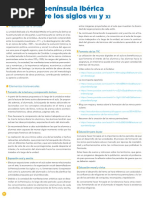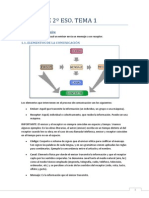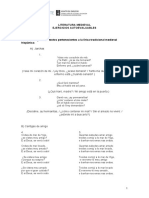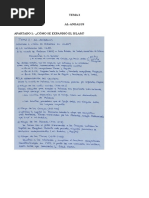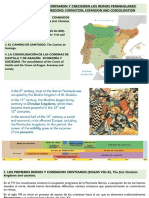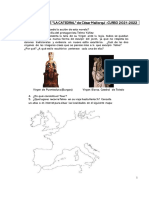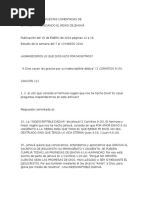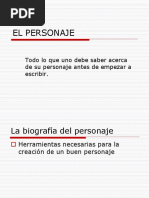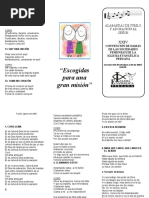1º Eso Prehistory
1º Eso Prehistory
Cargado por
anisgaraCopyright:
Formatos disponibles
1º Eso Prehistory
1º Eso Prehistory
Cargado por
anisgaraDescripción original:
Derechos de autor
Formatos disponibles
Compartir este documento
Compartir o incrustar documentos
¿Le pareció útil este documento?
¿Este contenido es inapropiado?
Copyright:
Formatos disponibles
1º Eso Prehistory
1º Eso Prehistory
Cargado por
anisgaraCopyright:
Formatos disponibles
CONSEJERÍA DE EDUCACIÓN
Dirección General de Participación e Innovación Educativa
Identificación del material AICLE
TÍTULO Prehistory
NIVEL LINGÜÍSTICO
A2.1
SEGÚN MCER
IDIOMA Inglés
ÁREA / MATERIA Ciencias Sociales (Geografía e Historia)
NÚCLEO TEMÁTICO La Prehistoria (Paleolítico, Neolítico y Edad de los Metales).
El tema no pretende ser un análisis exhaustivo de la prehistoria. Se centra solo
GUIÓN TEMÁTICO
en determinados aspectos; el resto será tratado en español.
FORMATO Material didáctico en formato PDF
CORRESPONDENCIA
1º de Educación Secundaria
CURRICULAR
AUTORÍA Antonio Rus Martínez
He secuenciado la unidad en 5 sesiones:
- Sesión 1: Actividad inicial de motivación, Brain Storming y presentación del
vocabulario y de la unidad. What is Prehistory?
TEMPORALIZACIÓN
- Sesión 2: The origin of man
APROXIMADA
- Sesión 3: Hominization
- Sesión 4 What was Prehistoric art like?
- Sesión 5: Final activities
Competencias específicas del área:
Competencia espacial (a través del análisis de mapas), competencia temporal
(ordenación cronológica de los hechos de la Prehistoria), competencia cultural y
COMPETENCIAS artística (valoración y producción de obras de arte).
BÁSICAS Competencias generales:
Comunicación lingüística, Tratamiento de la información y competencia digital,
competencia para aprender a aprender, competencia social y ciudadana, au-
tonomía e iniciativa personal.
- La unidad está pensada para trabajarla en su conjunto, pero también con la
opción de hacer cada parte de forma independiente
OBSERVACIONES
- Algunas de las actividades finales están pensadas para atender a la diversidad
(ej. Readings).
Material AICLE. 1º de ESO: Prehistory
3
Tabla de programación AICLE
- Comprender y expresarse en una o más lenguas extranjeras de manera apropiada
- Conocer, valorar y respetar los aspectos básicos de la cultura y la historia propias y
OBJETIVOS de los demás, así como el patrimonio artístico y cultural
- Apreciar la creación artística y comprender el lenguajede las distintas manifesta-
ciones artísticas,utilizando diversos medios de expresión y representación
CONTENIDOS DE
Bloque 3. Sociedades prehistóricas, primeras civilizaciones y edad antigua
CURSO / CICLO
- What is Prehistory?
- The origin of man
- Hominization
TEMA
- What was Prehistoric art like?
- Adquisición del vocabulario básico de la unidad
-Learning from History
- Identificar obras de arte según las características del Paleolítico o del Neolítico
MODELOS
- Interpretar mapas históricos
DISCURSIVOS
- Reflexionar sobre la crisis como oportunidad
- Tablas-resumen a completar sobre los períodos de la Prehistoria y los tipos de
homínidos a partir de la lectura de un texto
- Textos originales sobre la creación del hombre (Biblia) y la teoría evolucionista
(Darwin)
TAREAS
- Mapa en el que se analizarán los yacimientos prehistóricos más importantes de la
Prehistoria
- Imágenes de arte paleolítico que los alumnos tienen que describir oralmente
- Ejercicios sobre el arte del Paleolítico del tipo verdadero y falso
FUNCIONES: ESTRUCTURAS: LÉXICO:
- Explicar procesos - Comparativo (taller, Ancestors, human beings,
paso a paso slimmer, finer…). hunting, fishing, gathering,
- Imaginar - Para el diálogo (Did you wild fruit, agriculture,
respuestas find__________?, Look, cattle raising, discovery,
CONTENIDOS (guessing) __________’s here.) ape, stone tools, human
LINGÜÍSTICOS - Interpretar gráficos - Phrasal verbs (To take remains, bifaces. bone,
-Dar opciones place). ivory, cave, shelter,
basados a datos - Expresiones (To walk on brushes, deer, bison,
históricos two feet, to walk upright, to horse, mammoths, tombs.
bury their dead). - Verbos irregulares (To be,
to begin, to have, to take)
- Localizar lugares o espacios en un mapa y obtener información sobre el espacio
representado a partir de la leyenda.
- Utilizar las convenciones y unidades cronológicas y las nociones de evolución y
CRITERIOS DE
cambio aplicándolas a los hechos y procesos de la prehistoria.
EVALUACIÓN
- Realizar una lectura comprensiva de fuentes de información escrita de contenido
geográfico o histórico y comunicar la información obtenida de forma correcta por
escrito.
4 Material AICLE. 1º de ESO: Prehistory
Two scenes from 2001: A Space Odyssey, a 1968 science fiction film directed by Stanley Kubrick.
Observe and think
1. What does the first image represent? How about the second?
2. How much time separates the narrator from the first image to the second?
3. What do you think the driving force of the human evolution has been?
In the first unit we are going to centre on the origins of man
and his first encounters on the road of history. It will be a
fascinating trip that will make us learn, think and enjoy it.
CONTENTS
1. Vocabulary
2. What is Prehistory?
3. The origin of man
4. Hominization
5. What was Prehistoric art like?
6. Project
7. Final activities
8. Learning from History
9. What I have learned
10. Bibliography and links
Material AICLE. 1º de ESO: Prehistory
5
1. Vocabulary
Names
Ask your teacher/assistant for a definition of
Adjectices
- Nomadic:
- Sedentary:
- Huge:
- Skilful:
- Wise:
- Realistic:
- Schematic:
Comparative
- Tall/er:
- Big/ger:
- Short/er:
- Slim/mer:
Irregular verbs
- To be (was /were):
- To begin (began):
- To have (had):
- To take (took):
- It took place:
- They are called:
- They could have practised:
- To be able (they were able):
- To be found (there were found):
Expressions
- To walk on two feet:
- To walk upright:
- To bury their dead:
6 Material AICLE. 1º de ESO: Prehistory
2. What is Prehistory?
Prehistory: It is the period that begins with our first ancestors, about four
million years ago, and finishes with the invention of writing, about 3,000
B.C. There was no written texts during this period.
Prehistory is divided into three periods:
The Palaeolithic The Neolithic Age The Metal Ages
Age (from paleo (from neo new and began about 7,000
old and lithos stone) lithos stone) began years ago. Human
extends from our about 9,000 B.C. beings learned to
first ancestors to to the invention of
use metals to make
about 9,000 B.C. writing, about
objects.
The first human 3,000 B.C. Human
beings lived from beings lived from
hunting, fishing agriculture and
and gathering cattle raising and
wild fruit and were were sedentary.
nomadic.
Bronze Age weaponry and
A hand mill ornaments
A biface
Activities
1. What is Prehistory?
2. Complete this table.
-From… …to. Etimology Characteristics
-What happened? -What happened?
Palaeolithic
Age
Neolithic
Age
Metal Ages
X X
3. SPEAKING!! Make sentences with the information you have learned. For example:
The Palaeolithic Age is the period that started 4 millions years ago with our first
ancestors and finished in 9,000 B.C. with the invention of writing. It means “old stone”
and its main characteristics are…
Material AICLE. 1º de ESO: Prehistory
7
3. The origin of man
We begin with a fascinating topic: the origin of man. As you all know,
traditionally there has been two ways to study the question: one says that the
world and man were created by God (Creation) and the other says that all
species proceeded from a unique common ancestor (Evolution). We are going
to work on these two types of theories through the following texts.
1) Read the two proceeding texts using a dictionary to help you translate
the words that you don’t understand.
TEXT A TEXT B
1. In the beginning God created the heavens and “In considering The Origin Of Species, it
the earth. (…) is quite sure that a naturalist, reflecting
on the mutual affinities of organic
7 Then the LORD God formed man of dust from beings, might come to the conclusion
that each species had not been
the ground, and breathed into his nostrils independently created, but had
the breath of life. (…) descended, like varieties from other
species.
Michelangelo´s The Creation of Adam.
21 So the LORD God caused a deep sleep to fall
upon the man, and he slept; then He took
one of his ribs and closed up the flesh at
that place.
22 The LORD God fashioned into a woman the As many more individuals of each
species are born than can possibly
rib which He had taken from the man,
survive; and as, consequently, there is a
and brought her to the man. frequently recurring struggle for
existence, it follows that any being, if it
23 The man said, varies however slightly in any manner
“This is now bone of my bones, profitable to itself, under the complex
and sometimes varying conditions of
And flesh of my flesh;
life, will have a better chance of
She shall be called Woman, surviving, and thus be naturally
Because she was taken out of Man.” selected”.
http://bible.logos.com/passage/nasb/Genesis http://www.vectorsite.net/taorgin_01.html#m1
8 Material AICLE. 1º de ESO: Prehistory
Activities
2. Fill out the following table
TEXT A TEXT B
Principal
idea Principal idea l
Another idea that has caught Another idea that has caught
your attention your attention
The name of the work that The name of the work that
precedes the text precedes the text
Author of the text Author of the text
With theory classifies the text? With theory classifies the text?
3. Which of the two theories classifies the following images? Describe them.
Theory: Theory:
Description: Description:
4. Which of the two theories do you agree with? Why?
Material AICLE. 1º de ESO: Prehistory
9
4. Hominization
Hominization: It is the evolutionary process that results in the present
human being. It was a very long process.
Australopithecus
It means “southern ape”, because
the first discovery took place in
South Africa and they were very
similar to chimpanzees. However,
they walked on two feet. They were
about 1,30 m tall and their brain
was between 400 to 550 cm3. They
gathered wild fruit and lived about
four million years ago in Africa (For
example, Lucy, “grandmother of
humanity”).
Homo habilis
It means skilful, because they
made stone tools. These appeared
two million years ago. Their brain
was bigger and they were taller.
They lived from hunting and
gathering.
Homo erectus
These appeared one and a half
million years ago. They walked
upright (that is why they are called
“erectus”). This was the first species
to live outside Africa (in Europe
and Asia). They discovered fire
and made bifaces (a two-sided stone
tool). They were excellent hunters.
10 Material AICLE. 1º de ESO: Prehistory
Homo antecessor
They were the oldest human
remains in Europe. They lived in
Atapuerca, Spain. They are called
antecessor because they might be
the direct antecedent to the next
species. They could have practised
cannibalism. They are more than 1
million years ago. Model of a female Homo antecessor practicing
cannibalism (Ibeas Museum, Burgos, Spain).
Homo sapiens neanderthalensis
(Neanderthal)
The Neanderthal is named after
the neandertal valley (Germany),
where there were found fossils of
this specie. They lived in Europe
150,000 years ago. They were
stronger that we are but shorter.
They were the first species to bury
their dead. It seems they were
able to speak.
Homo sapiens sapiens
It means wise man. Our species
appeared in Africa about 130,000
years ago. Homo sapiens were
slimmer but taller than
Neanderthals. They were able to
make finer tools. They created art.
What do they have in common those two pictures?
Material AICLE. 1º de ESO: Prehistory
11
The increase in hominin cranial capacity over time
(http://www.readingevolution.com/images/hominid_brain_cavity_size.jpg)
Activities
1. Explain the meaning of hominization and biface.
2. Copy this table in your notebook and complete it.
Etymology Antiquity Main physical Innovations Where
characteristics:
Hominid brain,
did they
height… live?
Australopithecus
Homo habilis
Homo erectus
Homo antecesor
Neanderthal
Homo sapiens
sapiens
3. Read the sentences. What do they refer to?
- They created art.
- They lived in Atapuerca, Spain.
- They were the first species to bury their dead.
- They made the first stone tools.
- They were similar to chimpanzees but walked on two feet.
12 Material AICLE. 1º de ESO: Prehistory
4. Match the words to their sentences:
Australopithecus - The first species to live outside Africa.
Homo Habilis - Their brain was about 500 cm3.
Homo erectus - It means skilfull.
- They could have practised cannibalism.
Homo antecessor
- It seems they were able to speak.
Neanderthal
- They were able to make finer tools.
Homo sapiens sapiens
5. Interpreting a historical map. A historical map is a representation of a
place at a moment in the past.
http://www.britannica.com/EBchecked/topic-art/275670/71609/The-increase-in-hominin-cranial-capacity-over-time
Think and answer these questions.
a. What topic is shown in the map?
b. What does the symbol � indicate?
c. What is the meaning of the different colours?
d. Where did our first ancestors appear?
e. Name the places (or continents) where the different hominid lived.
Australopithecus:
Homo habilis:
Homo erectus:
Homo antecessor:
Neanderthal:
Homo sapiens sapiens:
Material AICLE. 1º de ESO: Prehistory
13
5. What was Prehistoric art like?
Just like today, our ancestors had an artistic sensibility. Human beings
started decorating their caves and objects about 35,000 years ago.
Painting on the wall: yesterday and today.
Palaeolithic art
Palaeolithic art can be divided into two groups: Mobiliary art and parietal art.
- Mobiliary art: It is the one that can be moved. It can be made of
stone, bone, ivory… For example, the venus figurines, statuettes of
women with certain parts of the human anatomy exaggerated
(abdomen, hips, breast, vulva) while others are smalls and with no
detail (head).
Venus of Willendorf and Venus of Lespugue
Did you know…?
Venus figurines are very little, between 4 cm and 25 cm in height.
14 Material AICLE. 1º de ESO: Prehistory
- Cave art or parietal art: art on the walls of caves and shelters. For
example, the Franco-Cantabrian art.
The Altamira cave paintings.
Parietal art had the following characteristics:
- Animals, such as deer, bison, horses and mammoths were often
represented without men.
- The paintings were realistic (naturalistic).
- They were painted in the secrecy of caves.
- They used colours like red, brown, yellow and black.
- Animal hair was used to make brushes. Sometimes, they painted
with their hands.
Neolithic art
Many of the painting are in the Levantine area of the Iberian peninsula.
They had the following characteristics:
- Scenes with frequent representation of men.
- The paintings were not realistic with figures very schematic.
- They were painted in the open air (shelter).
La Danza del Cogul (Lérida) and the Indalo (Cave of “Los letreros”, Vélez Blanco)
Material AICLE. 1º de ESO: Prehistory
15
Megalithic monuments
In the last years of the Neolithic Age, and during the Metal Ages,
monuments were built with big blocks of stone (the word 'megalith'
comes from the Ancient Greek mega meaning “great”, and lithos
meaning “stone”).
The most common type of megalithic constructions are:
Menhirs: (From Breton: Dolmen: (Dolmen" Stone circle: Several
men “stone”, and hir “long”)) originates from the expression
taol maen, which means
menhirs making
Single, vertical "stone table" in Breton) circles. They
stones. They could horizontal stones probably had a
be connected to supported by religious function.
the cult of the Sun. several vertical
stones. They were
used as tombs.
Activities
1. Complete this text.
a. Palaeolithic art can be divided into two groups: _________ art and
_____________ art.
b. The venus figurines are __________ of ________ .
c. Parietal art is on the _____ of caves.
d. Animals, such as _____, _____, ______ and __________ were often
represented.
e. In parietal art the paintings were _________.
f. Many of the neolithic painting are in the ____________ area of the
Iberian peninsula.
g. The ________ is an example of a Neolithic painting.
h. Stone circle are several _________ making circles.
i. Palaeolithic paintings were painted in the _________ of ________.
16 Material AICLE. 1º de ESO: Prehistory
2. Where does this word come from?
a. Megalithic:
b. Menhir:
c. Dolmen:
3. Mark T (True) or F (false). Then correct the false sentences.
1. Venus figurines had head exaggerated.
2. Venus figurines were very big.
3. The Franco-Cantabrian art is an example of Neolithic art.
4. In Neolithic art, the paintings were realistic.
5. Menhirs are horizontal stones supported by vertical stones.
1. __________________________________________________________________
2. __________________________________________________________________
3. __________________________________________________________________
4. __________________________________________________________________
5. __________________________________________________________________
4. Match the words to their picture:
Deer
Bison
Horses
Mammoths
5. Paint like a caveman! Make a drawing of a bison with the neolithic
and palaeolithic characteristics.
Palaeolithic Neolithic
Material AICLE. 1º de ESO: Prehistory
17
6. Are Those pictures Palaeolithic or Neolithic? Why?
7. Describe the painting.
8. Think. Why do you think people made mobiliary and cave art? Choose
one of the following answers.
Answer A Answer B
Men and women had a very hard life People made art in the Palaeolithic
and believed that supernatural forces Age to decorate their caves and
helped them in hunting, stopped objects.
children from dying and women were
more fertile. They made art to keep
these divinities favourable to them.
The oldest yet discovered Venus figurine from the archaeological cave site of Hohle Fels.
18 Material AICLE. 1º de ESO: Prehistory
6. Project
Look at that face! Isn´t she funny?
Do you want to know more?
http://ngm.nationalgeographic.com/2006/11/dikika-baby/sloan-text
The class is going to divide into groups to look for the information about
different hominids. Students will have to make a poster with all the
information and, after that, they will present their poster to the class.
Hominid:
Etimology:
Antiquity:
Main physical characteristics: brain, heigh…
Innovations:
Where did they live?
HOMINIDS: Lucy, Dikika baby, Selam, Peking Man, Java Man, Cro-
Magnon, Heidelberg Man, Homo floresiensis ( "Flores Man”)…
Material AICLE. 1º de ESO: Prehistory
19
7. Final activities
1. Look at the following pictures and describe them. The box bellow
might help you.
- The picture represents…
- It is a (sculpture, painting, Megalithic monuments).
- It was made of…
- It was made in the …
- It has the following characteristics…
- It probably had a _________ function.
- It is called…
20 Material AICLE. 1º de ESO: Prehistory
2. Look at this vocabulary from the unit. Work with a partner to
categorize them in the right box. Ask your partner what he or she thinks,
for example: “Where does nomadic go? I put Agriculture in the Palaeolithic Age, is
that right?” “No, I don’t think it is right.” Etc.
Nomadic Cattle raising Bifaces
Sedentary Bronze Indalo
Stone circles Iron Venus figurines
Old stone Dolmen Realistic paintings
Pulished stone Lucy Menhirs
Agriculture Homo antecesor Schematic
Paintings
The Palaeolithic Age The Neolithic Age The Metal Ages
3. Work with a partner to give a physical characteristic of the protagonists
in each image and try to determine what factor of measure it had to
adapt in order to acquire its present appearance.
Physical characteristic: Physical characteristic: Physical characteristic:
Reason: Reason: Reason:
Material AICLE. 1º de ESO: Prehistory
21
4. Word search. Find ten words related with Prehistory. Talk with your
classmates:
Did you find __________?
Where’s ___________?
Do you see __________?
I can’t find __________?
Look, __________’s here.
It’s next to __________.
22 Material AICLE. 1º de ESO: Prehistory
5. Do you want to listen to the song the Anthropologists were listening to when
they discovered Lucy? Complete the blanks and after tat underline the words
you don´t understand and look them up in a dictionary.
Lucy in the Sky with Diamonds
Picture yourself in a boat on a _____,
With tangerine trees and marmalade
skies.
Somebody calls you, you answer
quite slowly.
A girl with kaleidoscope ____.
Cellophane flowers of yellow and
_____,
towering over your head.
Look for the girl with the sun in her
eyes
and she's gone.
[Ref :] Lucy in the sky with ________
Lucy in the sky with diamonds …
Follow her downto a bridge by the
fountain,
where rocking horse ______ eat
marshmallow pies.
Everyone smiles as you drift past the
flowers,
that grow so incredibly high.
_________ taxis appear on the shore,
waiting to take you away.
Climb in the back with your ____ in the
clouds
and you're gone.
Picture yourself on a train in a _______,
with plasticine porters with looking
glass ties.
Suddenly someone is there at the
turnstile,
the girl with kaleidoscope eyes.
(McCartney/Lennon)
Recorded: March 1-2, 1967,
Abbey Road Studios, London.
Sgt. Pepper's Lonely Hearts Club
Band
Material AICLE. 1º de ESO: Prehistory
23
6. HAVING FUN: Expressing yourself through art!
Jean-Michel Basquiat was a very popular artist in the
New York art scene in the 1980’s. He started as a
graffiti artist and produced Neo-expressionist painting.
Just like the Palaeolithic men, Basquiat didn´t draw like
Leonardo or painted like Raphael, but he had
something to say and made beautiful pieces of art.
Make a drawing using your imagination. The
possibilities are endless as you let your imagination go.
You can inspire in the past (cave art) or in the present.
Just be creative. And remember, you don´t have to
be perfect, Just express yourself!
24 Material AICLE. 1º de ESO: Prehistory
7. Reading activities
Before 'Lucy,' There Was 'Ardi'.
First Major Analysis Of Early Hominid Published In Science
In a special issue of Science, an international team of scientists has for the first time described
Ardipithecus ramidus, a hominid species that lived 4.4 million years ago in what is now Ethiopia.
On October 1, 2009, paleontologists announced the discovery of a ardipithecus
ramidus fossil skeleton of a female, nicknamed "Ardi", that lived 4.4 million years ago,
more than a million years before Lucy (Australopithecus afarensis). It was discovered in
Ethiopia´s Afar desert and it is a very important discovery because Ardi, like Lucy,
walked on two feet, even though could not walk or run for long distances. The word
Ardi means "ground floor" in the Afar language.
Ardipithecus ramidus had a small brain,
measuring between 300 and 350 cm3.
This is about the same size as a modern
chimpanzee brain, but much smaller
than the brain of australopithecus like
Lucy (400 to 550 cm3). Ardi weighed
about 50 kilograms and stood about
120 centimeters tall.
“So when you go from head to toe,
you're seeing a mosaic creature, that is
neither chimpanzee, nor is it human. It is
Ardipithecus," said Tim White of the
University of California Berkeley, who is
one of the lead authors of the research.
These hominids appear to have lived in a woodland environment, where they climbed
on all fours along tree branches (as chimpanzees do) and walked, upright, on two legs,
while on the ground.
http://www.sciencedaily.com/releases/2009/10/091001110548.htm
Activity
Copy this table in your notebook and complete it.
Hominid Etimology Antiquity Main physical Innovations Where did they
characteristics: live?
Material AICLE. 1º de ESO: Prehistory
25
Regenerating a Mammoth for $10 Million
Scientists are talking for the first time about the old idea of resurrecting extinct
species, saying that a living mammoth could perhaps be regenerated for as little as
$10 million.
If the genome of an extinct species can be reconstructed, biologists can work out
the exact DNA differences with the genome of its nearest living relative. There are
talks on how to modify the DNA in an elephant’s egg so that after each round of
changes it would progressively resemble the DNA in a mammoth egg. The final-
stage egg could then be brought to term in an elephant mother, and mammoths
might once again roam the Siberian steppes.
The same technology could be applied to any other extinct species from which
one can obtain hair, horn, hooves, fur or feathers. For example with Neanderthals,
whose full genome is expected to be recovered shortly, but there would be several
ethical issues in modifying modern human DNA to that of another human species.
A woolly mammoth hair ball. Hairs like these were used to sequence the mammoth genome.
Adapted from The New York Times (Published: November 19, 2008)
Activities
1. What are scientists talking about for the first time?
2. How can they do that?
3. Could the same technology be applied to any other extinct species? Which one?
4. What is your opinion?
26 Material AICLE. 1º de ESO: Prehistory
“Those who refuse to learn from history are condemned to repeat it.”
Read
the
proceeding
documents
using
a
dictionary
to
help
you
translate
the
words
that
you
don’t
understand.
After
that,
do
the
activities.
TEXT A
Both Palaeolithic and Neolithic started with a huge crisis because of a
abrupt climate change. In the first one, the rainforest converted in sabana and our
first ancestors had to walk upright. In the second one, as the climate got drier,
people went to oases and became sedentary (the oasis theory). Because they had
little to eat, they observed that plants grew when seeds fell on the ground and this
is how agriculture started.
Human beings are capable of doing good things even in the worst circumstances.
TEXT B
Let´s not pretend that things will change if we do the same things. A crisis can be
something good to any person, to any nation, because all crisis bring progress.
Creativity is born from anguish, just like the day is born from the dark night. It´s in crisis
that discoveries are born. But the greatest inconvenience of people and nations is the
laziness. Incompetence is the true crisis. Let´s work hard instead.
There´s no challenge withot a crisis. Without challenges, life becomes a routine. There´s
no merit without crisis. It´s in the crisis where we can show the very best of us.
Material AICLE. 1º de ESO: Prehistory
27
Did you know that…?
The Chinese write with
symbols, with what they call
"ideograms". The word for
crisis is made of two
characters: one represents
dander and the other
represents opportunity.
Unfortunately, many people only see the danger in
crises and fail to look for the opportunities.
How about you?
Activities
1. Can you explain the principal idea of the first text?
2. Can you explain the principal idea of the second text?
3. Do you know the author of the second text?
4. Learning from the past… ¿Can you tell me how can we turn our Global
Economic and Climate Crisis into an opportunity?
5. Can you tell some examples on how one personal crisis can turn into an
opportunity?
28 Material AICLE. 1º de ESO: Prehistory
9. What I have learned
-From… …to. Etimology Characteristics
-What happened? -What happened?
Palaeolithic
Age
Neolithic
Age
Metal Ages
X X
Etymology Antiquity Main physical Innovations Where
characteristics:
Hominid brain,
did they
height… live?
Australopithecus
Homo habilis
Homo erectus
Homo antecesor
Neanderthal
Homo sapiens
sapiens
Palaeolithic art
Palaeolithic art can be divided into two groups: _________ art and ________
art.
1. Mobiliary art: It is the one that can be _______. It can be made of
______,______, _______ … For example, the _______ figurines
2. Cave art or parietal art: art on the walls of _______ and ________ . For
example, the _________________ art. Parietal art had the following
characteristics:
- Animals, such as ____, _____, _____ and ________ were often
represented without men.
- The paintings were _________ (naturalistic).
Material AICLE. 1º de ESO: Prehistory
29
Neolithic art
Many of the painting are in the _________ ____ of the Iberian peninsula.
They had the following characteristics:
- Scenes with frequent representation of ___.
- The paintings were not realistic with very _________ figures.
Megalithic monuments
In the last years of the Neolithic Age, and during the Metal Ages,
monuments were built with big ______ __ _____ (the word 'megalith'
comes from the Ancient Greek mega meaning “_____”, and lithos
meaning “_____”).
The most common type of megalithic constructions are:
1. Menhirs: Single, ________ stones.
2. Dolmen: __________ stones supported by several ________ stones. They
were used as _____.
3. Stone circle: Several _______ making _______. They probably had a
religious function.
The things that caught my attention the most in the unit were:
And don’t forget to study the vocabulary!!!!
Finally, read the following statements about skills and knowledge you have learned
during the unit. Please, circle one of these options:
YES NO NOT YET.
Self-assessment chart
Complete a chart with some YES NO
information given. NOT YET
Define concepts using my YES NO
I own words. NOT YET
CAN Describe and analyse a map. YES NO
NOT YET
Describe pictures. YES NO
NOT YET
Summarize the main ideas YES NO
from a text. NOT YET
30 Material AICLE. 1º de ESO: Prehistory
10. Bibliography and links
http://www.historiasiglo20.org/prehistory/index.htm
http://es.wikipedia.org/wiki/Wikipedia:Portada
http://maimonid.es/wp-content/uploads/2009/08/LaPrehistoria.pdf
http://www.sciencedaily.com/releases/2009/10/091001110548.htm
http://maimonid.es/wp-content/uploads/2009/08/LaPrehistoria.pdf
http://ngm.nationalgeographic.com/2006/11/dikika-baby/sloan-text
http://www.nytimes.com/2008/11/20/science/20mammoth.html
Imágenes
Todas las imagines son de Wikimedia Commons, o están bajo la licencia de Creative
Commons licences excepto:
- Imágenes del vocabulario
Ancestors
http://www.flickr.com/photos/32323502@N00/5290322
16 SortidozZ
http://www.flickr.com/photos/71088059@N00/3200122014
Cazador
http://www.flickr.com/photos/33666767@N02/3134640855
Pescador en el malecón
http://www.flickr.com/photos/8398214@N05/3214687264
Gathering
http://www.artelista.com/Gathering-Flowers-MS/09/mwm19434.jpg
Red
http://www.flickr.com/photos/35283995@N00/81975316
Deere colors!
http://www.flickr.com/photos/7578081@N07/2553979759
Dos amigas conversando
http://www.flickr.com/photos/25851862@N06/3048473230
Misty Eucalypt forest
http://www.flickr.com/photos/24761036@N00/3177050514
Untitled (ape)
http://www.flickr.com/photos/23117858@N02/2795285709
Prehistoric stone tools
http://www.flickr.com/photos/72105154@N00/2282291580
Remains
http://www.flickr.com/photos/84392129@N00/2877751049
Hueso
http://upload.wikimedia.org/wikipedia/commons/b/ba/Animal-leg-bone.jpg
African elephant
http://www.flickr.com/photos/15745225@N00/469568551
Tomorrow and the Next Day and the Day After That
http://www.flickr.com/photos/51035555243@N01/2371726871
Abrigo rocoso
http://lh4.ggpht.com/_lBWPPsPQZcc/SSy1aEGTW7I/AAAAAAAABVg/1qtUgwKg7yI/PIC_0212.JPG
Brushes
http://www.flickr.com/photos/25689440@N06/2829397204
Kiwi
http://www.flickr.com/photos/33602849@N00/2669602
- Hand mill
http://www.sahara-gems.com/sitebuildercontent/sitebuilderpictures/.pond/mill2.jpg.w300h230.jpg
- Imágenes evolucionismo
http://psicologia.laguia2000.com/wp-content/uploads/2007/08/la-fe-y-el-conocimiento.jpg
http://www.sedin.org/picsevo/ARBOLEV2.gif
- Hombre pintando paleolítico
http://hello4812-worldstudys.blogspot.com/2008_09_01_archive.html
- Grafitero
http://aula.elmundo.es/media/fotos/gr10001medi.jpg
- Venus figurine Hole Fels
http://archaeology.about.com/b/2009/05/13/oldest-venus-figurine-discovered-photo-essay.htm
- Imagen niña china
http://lacomunidad.as.com/blogfiles/iberebro/chinita.jpg
Material AICLE. 1º de ESO: Prehistory
31
- Niño negro y niña blanca
http://fe.img.v4.skyrock.net/fe0/florita-asilah/pics/1375833358.jpg
- Lucy in the sky with diamonds
http://dawsr.files.wordpress.com/2009/09/lucy.jpg
- Basquiat
http://nevandoenlaguinea.files.wordpress.com/2008/08/basquiat41.jpg
- Desierto oasis
http://www.fondosescritorio.net/wallpapers/Naturaleza/Desierto-2/Desierto.jpg
- Agricultura crisis
http://html.rincondelvago.com/000564051.jpg
- Einstein sacando la lengua
http://www.flickr.com/photos/26403449@N00/71661420
- Caracteres chinos crisis oportunidad
http://itre.cis.upenn.edu/~myl/languagelog/archives/004343.html
32 Material AICLE. 1º de ESO: Prehistory
También podría gustarte
- Libros 4 EsoDocumento1 páginaLibros 4 Esosara0% (3)
- Solucionario Nivel 1Documento8 páginasSolucionario Nivel 1Pablo20% (15)
- 03 PDDocumento16 páginas03 PDMaríaAún no hay calificaciones
- Lenguaje 2º Eso Tema 1 Comunicación y El Texto LiterarioDocumento9 páginasLenguaje 2º Eso Tema 1 Comunicación y El Texto LiterarioAna María Ros Domínguez100% (4)
- Grecia Anaya PDFDocumento14 páginasGrecia Anaya PDFdiazramiroAún no hay calificaciones
- 1º Eso Sociales Tema 11 RomaDocumento4 páginas1º Eso Sociales Tema 11 RomaAna Gonzalez CarrascosaAún no hay calificaciones
- Preguntas/Actividades 1 Eso de Geografía e HistoriaDocumento7 páginasPreguntas/Actividades 1 Eso de Geografía e HistoriaMayteMena75% (4)
- Examen Tema 5 Estructuras PDFDocumento1 páginaExamen Tema 5 Estructuras PDFjavigarciatecAún no hay calificaciones
- HGE1-U4-SESION 03 - Los Hombres Precerámico Tardío Y El Periodo InicialDocumento6 páginasHGE1-U4-SESION 03 - Los Hombres Precerámico Tardío Y El Periodo InicialJHONY MAYOAún no hay calificaciones
- Guia Taller Grado 11 Lengua Castellana PDFDocumento8 páginasGuia Taller Grado 11 Lengua Castellana PDFYenny PradaAún no hay calificaciones
- Fichas Tecnicas Equipo y Herramientas Varios PDFDocumento35 páginasFichas Tecnicas Equipo y Herramientas Varios PDFRamLopSor100% (1)
- Tema 5 2º Eso La Expansión de Los Reinos CristianosDocumento1 páginaTema 5 2º Eso La Expansión de Los Reinos CristianosruteacherAún no hay calificaciones
- 1º ESO G&H Tema 2 (Resumen) - Algaida ADocumento8 páginas1º ESO G&H Tema 2 (Resumen) - Algaida AMinervaAún no hay calificaciones
- Examen Repaso Inglés Tema 5 1 EsoDocumento6 páginasExamen Repaso Inglés Tema 5 1 EsoMaría Cristina100% (1)
- Actividades Refuerzo Oxford 1º EsoDocumento9 páginasActividades Refuerzo Oxford 1º EsoAngelSevillaCortesAún no hay calificaciones
- CS 2º EsoDocumento25 páginasCS 2º EsoVanessa Estefanía Cendagorta100% (1)
- Trabajo Recuperación Geografía e Historia 1 Eso 2017Documento12 páginasTrabajo Recuperación Geografía e Historia 1 Eso 2017Anonymous FqxxAOP45TAún no hay calificaciones
- Tema4 Lamineria La Energia y La Construccion. Vicens VivesDocumento30 páginasTema4 Lamineria La Energia y La Construccion. Vicens VivesAsuncion Pm0% (1)
- GEOGRAFÍA E HISTORIA TAREAS 1º ESO. 2 ParteDocumento8 páginasGEOGRAFÍA E HISTORIA TAREAS 1º ESO. 2 ParteOlga Maria Domínguez Pulido100% (1)
- Examen Geografía e Historia Tema 02.2 1º Eso CDocumento2 páginasExamen Geografía e Historia Tema 02.2 1º Eso CAna Belén Jiménez RojasAún no hay calificaciones
- 2ºeso LOS DESCUBRIMIENTOS GEOGRÁFICOS C Vicens VivesDocumento2 páginas2ºeso LOS DESCUBRIMIENTOS GEOGRÁFICOS C Vicens VivesprofeRoge77Aún no hay calificaciones
- Examen CCSS ESO 1E TEMA 7 CorregidoDocumento7 páginasExamen CCSS ESO 1E TEMA 7 Corregidoluism1683Aún no hay calificaciones
- Lírica Edad Media 3º ESODocumento20 páginasLírica Edad Media 3º ESOEvaAún no hay calificaciones
- Preguntas U.2 TecnologíaDocumento2 páginasPreguntas U.2 TecnologíaYolanda Fernandez AlfayaAún no hay calificaciones
- Biología 3ºESO: Órganos de Los SentidosDocumento21 páginasBiología 3ºESO: Órganos de Los SentidosAlberto DíazAún no hay calificaciones
- Geografia e Historia 20-21 Tema 1Documento4 páginasGeografia e Historia 20-21 Tema 1Aguilera Cabezas GonzaloAún no hay calificaciones
- LF 070616 Hispania en La Antiguedad Resumen EsDocumento3 páginasLF 070616 Hispania en La Antiguedad Resumen EsMarianMontesdeocaAún no hay calificaciones
- Refuerza Lo Que Has Aprendido Cultura Clásica 2º EsoDocumento9 páginasRefuerza Lo Que Has Aprendido Cultura Clásica 2º Esofergo1Aún no hay calificaciones
- Geografía e Historia ESO 11 - 12Documento61 páginasGeografía e Historia ESO 11 - 12FREDDYALBERTO40% (5)
- Esquemas y Enlaces Tema 2Documento9 páginasEsquemas y Enlaces Tema 2Francisco Javier Ramos VillaránAún no hay calificaciones
- Examen MúsicaDocumento2 páginasExamen Músicacarolinasalvoc100% (1)
- Roma 1º Eso BilingüeDocumento33 páginasRoma 1º Eso BilingüeLlanetes López100% (1)
- Refuerzo Algaida Tema 3 LenguaDocumento7 páginasRefuerzo Algaida Tema 3 LenguaAbraham Ortega MorenoAún no hay calificaciones
- GH 1ESO GeografíaeHistoriaDocumento6 páginasGH 1ESO GeografíaeHistoriaMarianoAún no hay calificaciones
- Resumen Física y Química La Materia 2 Eso Tema 2 AnayaDocumento2 páginasResumen Física y Química La Materia 2 Eso Tema 2 AnayaNenupharum50% (2)
- TALLER Soluciones. LENGUA Y LITERATURA 2º ESO PDFDocumento6 páginasTALLER Soluciones. LENGUA Y LITERATURA 2º ESO PDFAngelica Suarez Suarez100% (3)
- TEMA 3. Feudalismo 2º EsoDocumento1 páginaTEMA 3. Feudalismo 2º EsoAcademiaOhana CeutaAún no hay calificaciones
- CONTROL FUNCIONES 4º Eso PDFDocumento3 páginasCONTROL FUNCIONES 4º Eso PDFMj FdezAún no hay calificaciones
- Resumen de La Prehistoria 1º EsoDocumento12 páginasResumen de La Prehistoria 1º EsoAlejandro Fernández Rodríguez100% (1)
- Tema 6. LA TIERRADocumento4 páginasTema 6. LA TIERRAPablo Mendez BenitezAún no hay calificaciones
- Programacion en Spirale 1ESODocumento96 páginasProgramacion en Spirale 1ESOJosePiqueras0% (1)
- Ficha de Actividades Unidad 4-El Clima y Las Zonas BioclimáticasDocumento4 páginasFicha de Actividades Unidad 4-El Clima y Las Zonas BioclimáticasMaríaAún no hay calificaciones
- Richmond Fast 1eso Unit8Documento6 páginasRichmond Fast 1eso Unit8MariCarmen ZarcoAún no hay calificaciones
- G y H 3º Eso Examenes PDFDocumento9 páginasG y H 3º Eso Examenes PDFyolandaAún no hay calificaciones
- Unidad 5 - ¿Cómo Se Formaron y Crecieron Los Reinos Peninsulares - Unit 5 - Peninsular Kingdoms - Formation, Expansion and ConsolidationDocumento17 páginasUnidad 5 - ¿Cómo Se Formaron y Crecieron Los Reinos Peninsulares - Unit 5 - Peninsular Kingdoms - Formation, Expansion and ConsolidationManuel SoriaAún no hay calificaciones
- CCSS - 1 ESO - AND - Prueba de Evaluacion PDFDocumento3 páginasCCSS - 1 ESO - AND - Prueba de Evaluacion PDFErica BennettAún no hay calificaciones
- Tema 4 Guía de Estudio Civilización RomanaDocumento4 páginasTema 4 Guía de Estudio Civilización Romanageohistoria23Aún no hay calificaciones
- Ejercicios 1 Eso SocialesDocumento25 páginasEjercicios 1 Eso SocialesQuecha Fafián Seoane75% (4)
- TRABAJO La Catedral 2021-22Documento5 páginasTRABAJO La Catedral 2021-22Itziar Garcia0% (1)
- Ev 1 ESO SocialesDocumento1 páginaEv 1 ESO SocialesSheiAún no hay calificaciones
- Geografia ESODocumento3 páginasGeografia ESOmontserrat inguanzo100% (1)
- CCSS - 1 ESO - AND - Adaptacion Curricular PDFDocumento10 páginasCCSS - 1 ESO - AND - Adaptacion Curricular PDFErica BennettAún no hay calificaciones
- Ficha 1ero Sec Los Morfemas Seman 6 FinalDocumento1 páginaFicha 1ero Sec Los Morfemas Seman 6 FinalgabitocopAún no hay calificaciones
- Materiales CroniñónDocumento53 páginasMateriales CroniñónmartunflisAún no hay calificaciones
- ¿ Que Es La Historia ¿Documento2 páginas¿ Que Es La Historia ¿Billy RodriguezAún no hay calificaciones
- UUDD10 - 4ºesoDocumento3 páginasUUDD10 - 4ºesoMarta SaboridoAún no hay calificaciones
- Historia Universal 1er CapituloDocumento6 páginasHistoria Universal 1er CapituloRoman Torres0% (1)
- Conociendo La Primera Cultura Perteneciente Al Intermedio Temprano Que Se Dearrollo en El Norte Del PerúDocumento13 páginasConociendo La Primera Cultura Perteneciente Al Intermedio Temprano Que Se Dearrollo en El Norte Del PerúShirley PinedoAún no hay calificaciones
- 03 Primeros Edificios Públicos en Nuestro TerritorioDocumento6 páginas03 Primeros Edificios Públicos en Nuestro TerritorioProf. Daniel Harpper50% (2)
- Estrategia Didáctica ExitosaDocumento1 páginaEstrategia Didáctica ExitosaAlejandra BerrellezaAún no hay calificaciones
- La HistoriaDocumento1 páginaLa HistoriaFIDES IUSTITIA ET LIBERTASAún no hay calificaciones
- Accesorios Sabaot. Plan de NegociosDocumento12 páginasAccesorios Sabaot. Plan de Negociosjuanko_007Aún no hay calificaciones
- Dejame Estar Diego TorresDocumento2 páginasDejame Estar Diego TorresjpiacarusoAún no hay calificaciones
- KimonoDocumento11 páginasKimonoMariana Carvalho100% (1)
- Bibliografía Sobre La Historia de Las Bibliotecas y La Imprenta en La República Argentina Por Roberto Mallalieu y ColaboradoresDocumento4 páginasBibliografía Sobre La Historia de Las Bibliotecas y La Imprenta en La República Argentina Por Roberto Mallalieu y ColaboradoresEduardo Rubí100% (2)
- Arquitectura ListoDocumento13 páginasArquitectura Listothe consentidoAún no hay calificaciones
- Semana 04Documento3 páginasSemana 04normanAún no hay calificaciones
- Preguntas y Respuestas Comentadas de Atalaya Del 7 Al 13 de MarzoDocumento12 páginasPreguntas y Respuestas Comentadas de Atalaya Del 7 Al 13 de Marzochechin33Aún no hay calificaciones
- Comprension Lectora 2 NivelDocumento4 páginasComprension Lectora 2 NivelJosseline CamposAún no hay calificaciones
- EL TEATRO GRIEGO - Copia 1Documento9 páginasEL TEATRO GRIEGO - Copia 1Constantino GutierrezAún no hay calificaciones
- Actividad 04 ? Hombres Nec Ios Que Acusáis-Folio PDFDocumento2 páginasActividad 04 ? Hombres Nec Ios Que Acusáis-Folio PDFmarco_alcalá_1100% (1)
- 8basico - Guia Trabajo Lengua y Literatura - Semana 23Documento2 páginas8basico - Guia Trabajo Lengua y Literatura - Semana 23Sonia del Carmen Varas VarasAún no hay calificaciones
- Monereo Cap 1 Las Estrategias de AprendizajeDocumento24 páginasMonereo Cap 1 Las Estrategias de AprendizajeEdith salazarAún no hay calificaciones
- Presencial Componentes Electronicos - MicroElectronicaDocumento170 páginasPresencial Componentes Electronicos - MicroElectronicaFabian Rojas100% (1)
- Catalogo Bachas FrankeDocumento36 páginasCatalogo Bachas FrankejuanAún no hay calificaciones
- El Cuento Como Recurso DidacticoDocumento0 páginasEl Cuento Como Recurso Didacticocarmenverde19Aún no hay calificaciones
- El Idioma Del Delito - Antonio DellepianeDocumento131 páginasEl Idioma Del Delito - Antonio DellepianeJavier Isaac Ruiz MestraAún no hay calificaciones
- Duromit PDFDocumento2 páginasDuromit PDFAnonymous sCdrse3sAún no hay calificaciones
- Dios y El Fundamento de Verdad en La ModernidadDocumento8 páginasDios y El Fundamento de Verdad en La ModernidadIvan LoyolaAún no hay calificaciones
- Biografia de Personajes en GuiónDocumento13 páginasBiografia de Personajes en GuiónOli De CristobalAún no hay calificaciones
- Coros Convencion de Damas (2003)Documento3 páginasCoros Convencion de Damas (2003)Julio Peña QuispeAún no hay calificaciones
- Antologia PersonalDocumento2 páginasAntologia PersonalPacho SalqakayAún no hay calificaciones
- Movimientos Literarios Del Siglo XX Generación Del 98Documento8 páginasMovimientos Literarios Del Siglo XX Generación Del 98ysigaztelaniaAún no hay calificaciones
- FOX - Estructuras Totémicas en La Barraca de Blasco Ibáñez PDFDocumento9 páginasFOX - Estructuras Totémicas en La Barraca de Blasco Ibáñez PDFMalena ManiAún no hay calificaciones
- Critica Del Juicio KantDocumento1 páginaCritica Del Juicio KantvanesaAún no hay calificaciones
- Actividad 5 M04 - S3 - Ai5Documento5 páginasActividad 5 M04 - S3 - Ai5ARIADNA LUJA100% (1)
- La Festividad Religiosa de San Pedro y San PabloDocumento2 páginasLa Festividad Religiosa de San Pedro y San PabloSerisawa Csaint100% (1)
- MV 791 1952Documento14 páginasMV 791 1952Grupo GesmarAún no hay calificaciones
- Arte de La IndiaDocumento17 páginasArte de La IndiaCarmen JonesAún no hay calificaciones


